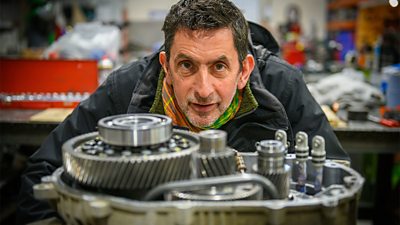Blue Lights series two: energy, travel and on-screen portrayal
To ensure the second series of Northern Ireland based police drama Blue Lights was as sustainable as possible, indie Two Cities Television took an environmentally friendly approach in multiple production areas, with a particular focus on cutting power usage, travel emissions within Northern Ireland and paper wastage.
By renting a semi-permanent site for use as their unit base, production offices, departmental stores and for set builds and exterior filming, they reduced the production’s travel emissions within Northern Ireland. Most significantly, this centralised base also enabled them to drastically reduce fossil fuel usage by installing a three-phase power supply so they could draw on mains power on a renewable tariff, rather than relying on diesel fuelled generators.
When it wasn’t possible to run off the mains, they used certified Hydrotreated Vegetable Oil (HVO) fuel in their generators, including for the trucks, locations generator, lighting tower, catering and facilities generators. This fuel is an easy switch with standard diesel but creates significantly less carbon pollution.
The production office was able to recycle paper and stationary from other productions shooting in Belfast, considerably cutting their paper usage.
Additionally, the producers, writers and script editor took the opportunity to portray sustainable behaviours on screen, showing the use of reusable coffee cups and food boxes, plant-based food options and home-cooking which reduces packaging waste.
Two Cities’ fantastic work will now be used to inform how their future productions can be more sustainable and they will be sharing learnings with other local projects to help accelerate Northern Ireland’s transition to low-carbon production.
���˿��� News: using mains power
���˿��� News have been plugging into the grid wherever possible. It’s an option at sites regularly used for filming, particularly in London. Locations with plug-in points include Canada Gate and Downing Street. Film London have recently worked with partners to install a new plug-in point in Victoria Park in Hackney to eliminate not just carbon dioxide emissions, but also those of particulate matter and nitrogen dioxide, and significantly reduce noise pollution. In the first three months, seven productions have drawn power from it already and research estimates usage will save 64,000 litres of diesel annually and 170 tonnes of CO₂. Find out more about .
Silent Witness and Radio 1’s Big Weekend: battery hybrid
Silent Witness has trialled a hybrid set-up combining a battery with a standard generator to power their unit base. During the trial the battery reduced generator run time by approximately 40%, saving fuel, carbon and money, as well as improving noise and air quality for the cast and crew. ���˿��� Live Events have switched to a hybrid setup for Radio 1’s Big Weekend and other festivals, using recycled bus batteries which power smaller kit set-ups across the site. Generators are only turned on when the batteries are running low to top them up, significantly reducing fuel consumption.
Snooker, Women’s Super League and 6 Nations coverage: HVO
IMG Media have successfully switched to using HVO fuel in generators on site during their Snooker World Championship coverage in 2022 and 2023. It’s a fossil-free fuel made with waste fat and vegetable oils and significantly reduces carbon emissions. Whisper Films have also made the change, using generators powered by HVO for their coverage of Women’s Super League football and Women’s 6 Nations Rugby for several years. They’ve maximised the emissions reduction by combining HVO with a stage 5 modification of the generator. Apart from saving carbon, the production reports that, in their experience, fumes on-site have decreased, improving the working environment for everyone.
Winterwatch and Springwatch: green hydrogen
Winterwatch first trialled using green hydrogen in 2021 for backup and additional power generation, before being confident enough to power all 12 live Springwatch broadcasts that year with 100% clean energy. Based in ���˿��� Bristol, the hydrogen generator powered the Springwatch OB hub which broadcasts the show live. It’s the ‘control room’, overseeing and directing the production’s numerous live locations across the UK. If diesel generators had been used, seven tonnes of CO₂ would have been released into the atmosphere, in addition to other air pollutants such as nitrogen oxides and particulates. Hydrogen generators have now become an integral part of the set-up, being used again by the team in 2022 and 2023.
With thanks to for their contribution to the information on this page.
Please note the ���˿��� is not responsible for the content of external website.
Further resources
-
 Sustainability homepage All our requirements and further resources
Sustainability homepage All our requirements and further resources -
 Budgeting for sustainable productions Allocating costs for sustainable production practices
Budgeting for sustainable productions Allocating costs for sustainable production practices -
 Top tips for reducing carbon emissions Focus on energy and travel
Top tips for reducing carbon emissions Focus on energy and travel -
 Producers end-to-end production guide Everything you need to know across production and editorial
Producers end-to-end production guide Everything you need to know across production and editorial -
 Carbon footprint and albert certification Delivery requirements, contacts and further information
Carbon footprint and albert certification Delivery requirements, contacts and further information -
 In depth information on a range of climate topics
In depth information on a range of climate topics
